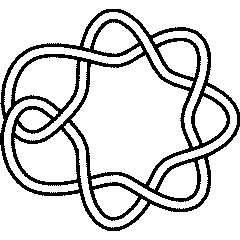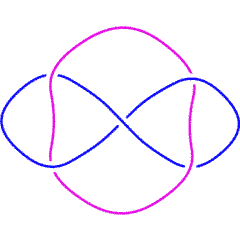The HOMFLY-PT Polynomial: Difference between revisions
No edit summary |
|||
| Line 15: | Line 15: | ||
<!--Robot Land, no human edits to "END"--> |
<!--Robot Land, no human edits to "END"--> |
||
{{HelpAndAbout| |
{{HelpAndAbout| |
||
n = |
n = 2 | |
||
n1 = |
n1 = 3 | |
||
in = <nowiki>HOMFLYPT</nowiki> | |
in = <nowiki>HOMFLYPT</nowiki> | |
||
out= <nowiki>HOMFLYPT[K][a, z] computes the HOMFLY-PT (Hoste, Ocneanu, Millett, Freyd, Lickorish, Yetter, Przytycki and Traczyk) polynomial of a knot/link K, in the variables a and z.</nowiki> | |
out= <nowiki>HOMFLYPT[K][a, z] computes the HOMFLY-PT (Hoste, Ocneanu, Millett, Freyd, Lickorish, Yetter, Przytycki and Traczyk) polynomial of a knot/link K, in the variables a and z.</nowiki> | |
||
| Line 26: | Line 26: | ||
<!--Robot Land, no human edits to "END"--> |
<!--Robot Land, no human edits to "END"--> |
||
{{In| |
{{In| |
||
n = |
n = 4 | |
||
in = <nowiki>K = Knot[8, 1];</nowiki>}} |
in = <nowiki>K = Knot[8, 1];</nowiki>}} |
||
<!--END--> |
<!--END--> |
||
| Line 33: | Line 33: | ||
<!--Robot Land, no human edits to "END"--> |
<!--Robot Land, no human edits to "END"--> |
||
{{InOut| |
{{InOut| |
||
n = |
n = 5 | |
||
in = <nowiki>HOMFLYPT[Knot[8, 1]][a, z]</nowiki> | |
in = <nowiki>HOMFLYPT[Knot[8, 1]][a, z]</nowiki> | |
||
out= <nowiki> -2 4 6 2 2 2 4 2 |
out= <nowiki> -2 4 6 2 2 2 4 2 |
||
| Line 44: | Line 44: | ||
<!--Robot Land, no human edits to "END"--> |
<!--Robot Land, no human edits to "END"--> |
||
{{InOut| |
{{InOut| |
||
n = |
n = 6 | |
||
in = <nowiki>Expand[HOMFLYPT[K][1/q, Sqrt[q]-1/Sqrt[q]]]</nowiki> | |
in = <nowiki>Expand[HOMFLYPT[K][1/q, Sqrt[q]-1/Sqrt[q]]]</nowiki> | |
||
out= <nowiki> -6 -5 -4 2 2 2 2 |
out= <nowiki> -6 -5 -4 2 2 2 2 |
||
| Line 55: | Line 55: | ||
<!--Robot Land, no human edits to "END"--> |
<!--Robot Land, no human edits to "END"--> |
||
{{InOut| |
{{InOut| |
||
n = |
n = 7 | |
||
in = <nowiki>Jones[K][q]</nowiki> | |
in = <nowiki>Jones[K][q]</nowiki> | |
||
out= <nowiki> -6 -5 -4 2 2 2 2 |
out= <nowiki> -6 -5 -4 2 2 2 2 |
||
| Line 66: | Line 66: | ||
<!--Robot Land, no human edits to "END"--> |
<!--Robot Land, no human edits to "END"--> |
||
{{InOut| |
{{InOut| |
||
n = |
n = 8 | |
||
in = <nowiki>{HOMFLYPT[K][1, z], Conway[K][z]}</nowiki> | |
in = <nowiki>{HOMFLYPT[K][1, z], Conway[K][z]}</nowiki> | |
||
out= <nowiki> 2 2 |
out= <nowiki> 2 2 |
||
| Line 83: | Line 83: | ||
<!--Robot Land, no human edits to "END"--> |
<!--Robot Land, no human edits to "END"--> |
||
{{In| |
{{In| |
||
n = |
n = 9 | |
||
in = <nowiki>L = Link[5, Alternating, 1];</nowiki>}} |
in = <nowiki>L = Link[5, Alternating, 1];</nowiki>}} |
||
<!--END--> |
<!--END--> |
||
| Line 93: | Line 93: | ||
<!--Robot Land, no human edits to "END"--> |
<!--Robot Land, no human edits to "END"--> |
||
{{InOut| |
{{InOut| |
||
n = |
n = 10 | |
||
in = <nowiki>Simplify[{ |
in = <nowiki>Simplify[{ |
||
(-1)^(Length[Skeleton[L]]-1)(q^2+1+1/q^2)HOMFLYPT[L][1/q^3, q-1/q], |
(-1)^(Length[Skeleton[L]]-1)(q^2+1+1/q^2)HOMFLYPT[L][1/q^3, q-1/q], |
||
Revision as of 18:22, 21 February 2013
The HOMFLY-PT polynomial (see [HOMFLY] and [PT]) of a knot or link is defined by the skein relation
and by the initial condition =1.
KnotTheory` knows about the HOMFLY-PT polynomial:
(For In[1] see Setup)
|
| ||||||||
Thus, for example, here's the HOMFLY-PT polynomial of the knot 8_1:
In[4]:=
|
K = Knot[8, 1];
|
In[5]:=
|
HOMFLYPT[Knot[8, 1]][a, z]
|
Out[5]=
|
-2 4 6 2 2 2 4 2
a - a + a - z - a z - a z
|
It is well known that HOMFLY-PT polynomial specializes to the Jones polynomial at and and to the Conway polynomial at . Indeed,
In[6]:=
|
Expand[HOMFLYPT[K][1/q, Sqrt[q]-1/Sqrt[q]]]
|
Out[6]=
|
-6 -5 -4 2 2 2 2
2 + q - q + q - -- + -- - - - q + q
3 2 q
q q
|
In[7]:=
|
Jones[K][q]
|
Out[7]=
|
-6 -5 -4 2 2 2 2
2 + q - q + q - -- + -- - - - q + q
3 2 q
q q
|
In[8]:=
|
{HOMFLYPT[K][1, z], Conway[K][z]}
|
Out[8]=
|
2 2
{1 - 3 z , 1 - 3 z }
|
 8_1 |
 L5a1 |
In our parametrization of the link invariant, it satisfies
where is some knot or link and where is the number of components of . Let us verify this fact for the Whitehead link, L5a1:
In[9]:=
|
L = Link[5, Alternating, 1];
|
In[10]:=
|
Simplify[{
(-1)^(Length[Skeleton[L]]-1)(q^2+1+1/q^2)HOMFLYPT[L][1/q^3, q-1/q],
A2Invariant[L][q]
}]
|
Out[10]=
|
-12 -8 -6 2 -2 2 4 6
{2 - q + q + q + -- + q + q + q + q ,
4
q
-12 -8 -6 2 -2 2 4 6
2 - q + q + q + -- + q + q + q + q }
4
q
|
Other Software to Compute the HOMFLY-PT Polynomial
A C-based program running under windows by M. Ochiai can compute the HOMFLY-PT polynomial of certain knots and links with up to hundreds of crossings using "base tangle decompositions". His program, bTd, is available at [1].
References
[HOMFLY] ^ J. Hoste, A. Ocneanu, K. Millett, P. Freyd, W. B. R. Lickorish and D. Yetter, A new polynomial invariant of knots and links, Bull. Amer. Math. Soc. 12 (1985) 239-246.
[PT] ^ J. Przytycki and P. Traczyk, , Proc. Amer. Math. Soc. 100 (1987) 744-748.









